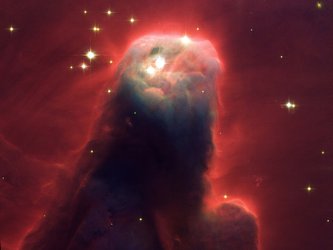Star-forming region in nebula NGC 346
NGC 346 is a star-forming region about 200 light-years across, found among the clusters and nebulae of the Small Magellanic Cloud, pictured here by the NASA/ESA Hubble Space Telescope.
The Small Magellanic Cloud (SMC) is a satellite galaxy of the Milky Way, visible to the naked eye in the southern constellation Tucana, and located 210 000 light-years away.
Here, Hubble astronomers have uncovered, for the first time, a population of infant stars. Embedded in the nebula NGC 346, these infant stars are still forming from gravitationally collapsing gas clouds. They have not yet ignited their hydrogen fuel to sustain nuclear fusion. The smallest of these infant stars is only half the mass of our Sun.
Although star birth is common within the disk of our galaxy, this smaller companion galaxy is more primeval in that it lacks a large percentage of the heavier elements that are forged in successive generations of stars through nuclear fusion.
Dwarf galaxies like the SMC are considered primitive building blocks of larger galaxies. Most of these types of galaxies existed far away, when the Universe was much younger. The SMC offers a unique nearby laboratory for understanding how stars arose in the early Universe. Nestled among other starburst regions within the small galaxy, nebula NGC 346 alone contains more than 2500 infant stars.
The Hubble Space Telescope is a project of international co-operation between ESA and NASA.















 Germany
Germany
 Austria
Austria
 Belgium
Belgium
 Denmark
Denmark
 Spain
Spain
 Estonia
Estonia
 Finland
Finland
 France
France
 Greece
Greece
 Hungary
Hungary
 Ireland
Ireland
 Italy
Italy
 Luxembourg
Luxembourg
 Norway
Norway
 The Netherlands
The Netherlands
 Poland
Poland
 Portugal
Portugal
 Czechia
Czechia
 Romania
Romania
 United Kingdom
United Kingdom
 Slovenia
Slovenia
 Sweden
Sweden
 Switzerland
Switzerland
































